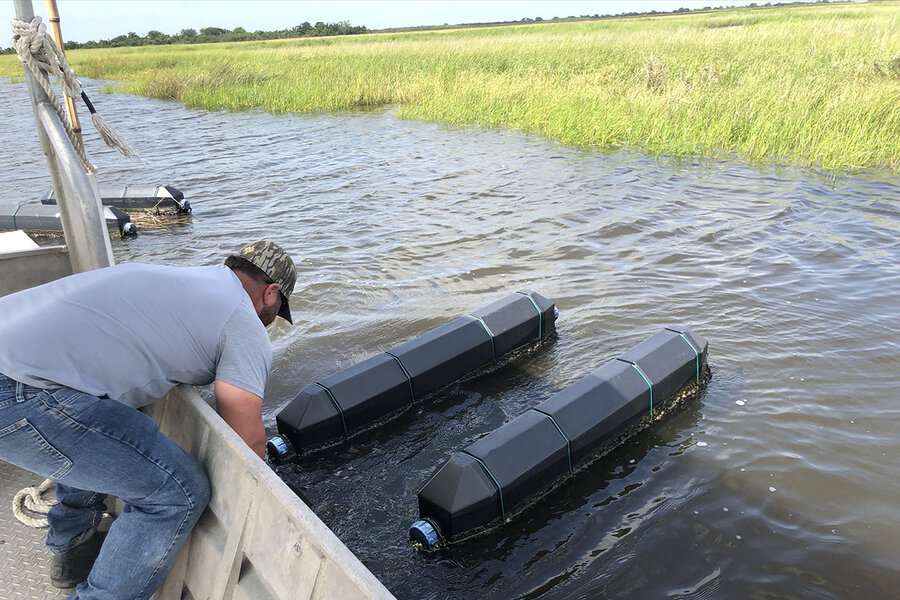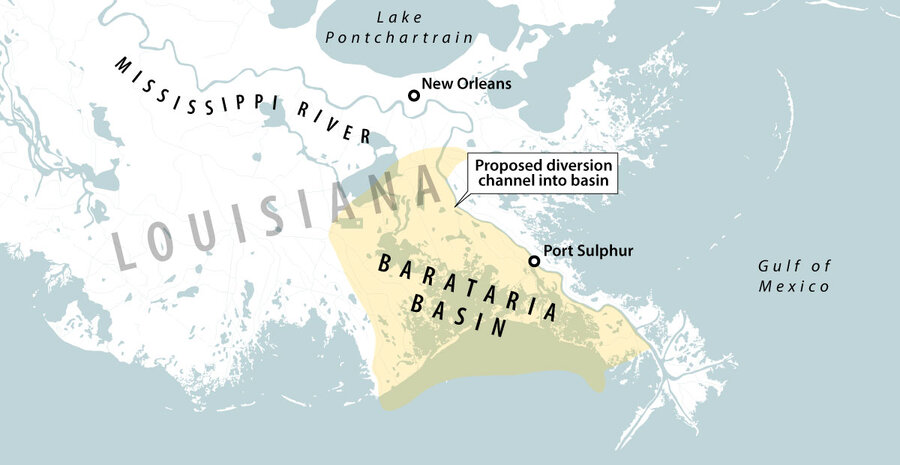An oysterman’s new worry: Will state’s coastal plan wash out his business?
Loading...
| Port Sulphur, La.
Sun-kissed lines frame Terry Shelley’s face like high tide stains a fishing dock. Today, those creases seem deepened by anger, but it’s the tone of his voice that gives it away.
Mr. Shelley has spent his entire working life as a commercial fisherman. Before he was a full-time oyster farmer and harvester, he spent the first part of his career harvesting shrimp and reef fish. He’s seen a lot, but not a pileup of challenges like now.
Back in September, Hurricane Zeta rumbled over small-town Port Sulphur, Louisiana, where the family’s oyster farm and processing center are based. The Shelleys lost half their cages, and they only managed to retrieve about half of that. Already by then, the COVID-19 pandemic had temporarily halted the supply lines Shelley Farms uses to sell its oysters.
Why We Wrote This
Coastal wetlands are a vital buffer in Louisiana against storms and rising sea levels. But a state plan to restore them is provoking responses as complex as the marshy ecosystems themselves.
Now, after losing most of his oyster crop last year, Mr. Shelley has another worry on his mind.
Louisiana coastal planners are pushing a $2 billion project proposal designed to fight back against the trend of persistent coastal erosion.
Few argue with the motive behind the plan, at a time of rising waters, increasingly intense storms, and projections that annual losses of coastal land will quicken. But Mr. Shelley sees the proposed answer – letting silt-laden river water flow again into the backwaters of Port Sulphur and other coastal communities – as a looming catastrophe for his oyster beds that depend on the current brackish blend in these waters.
“They know the oyster business is going to be the worst hit,” he says of state project managers.
His concerns, shared by many here, signal the complexities ahead as humans prepare to calibrate anew their own engineering of America’s mightiest river. The question is not just whether plans to divert water from the Mississippi into coastal wetlands will work. It’s also whether it can be done with adequate steps to address the distrust and economic hardship felt by many local residents.
“If you don’t do the project, my guess is you won’t have any recognizable fisheries within 25 years,” says Mark Davis, founding director of the Tulane Institute on Water Resources Law and Policy. He acknowledges the near-term challenges for people like Mr. Shelley, but he adds, “If you’re not reintroducing river water, you’re continuing to introduce Gulf water. Productively grown oysters, they exist in a band of brackish water – and we’re losing it.”
Coastal lands disappearing
The general idea behind the Mid-Barataria Sediment Diversion project is simple: By carving out a hole in a nearby levee, it will allow sediment-laden Mississippi River water to reach and rebuild wetlands. This mimicking of age-old natural processes could restore some of the more than 2,000 square miles of coast the state has lost – roughly the size of Delaware – since the 1930s.
The resulting wetlands would act as a barrier to protect both the coast and cities like New Orleans from future storm surges, a safeguard against another catastrophe like Hurricane Katrina in 2005. The project, which would be paid for with remaining fines and settlements from the 2010 Deepwater Horizon oil spill, is a key part of the state’s Coastal Master Plan, a 50-year, $50 billion crusade that the Louisiana Legislature revisits every five years.
By 2050, officials say the project would build up to 28 square miles of marsh in Barataria Bay.
The problem with the Mid-Barataria project, however, is that commercial fisherfolk and recreational charter guides alike fear that an increase in fresh water to their local ecosystems would devastate their important piece of the state’s $4 billion fishing industry.
Mr. Shelley laces his fingers across the chest, leans back, and mumbles under his breath. His deep Cajun accent has a way of lingering in your ear like a growl. “They know they’re going to destroy the business,” he says. “Literally destroy it. It’s going to turn this area into [another] Lake Pontchartrain,” whose nearby waters are too fresh for oystering.
Seagrass-roots opposition
The debate reflects America’s urban-rural divide.
Among environmentalists and state officials, the sediment diversion project is popular. So popular, in fact, that New Orleans Mayor LaToya Cantrell took to the pages of the state’s highest circulating newspaper last month voicing her support for the project and master plan.
“This is the time to support innovation, ingenuity and climate adaptation. This is the time to embrace living with water and to make it our great asset. It’s time to get involved and protect our coast and the future of our delta city,” Ms. Cantrell wrote in The Advocate, referring to how the Mid-Barataria project’s public comment period is currently underway.
Even so, opinions in fishing communities associated most closely with the project differ.
In Plaquemines Parish, home to Shelley Farms, the council voted unanimously (8-0) against the project in April. Later that month, neighboring St. Bernard Parish’s council also voted unanimously against the project.
Plaquemines Parish Council member Mark Cognevich says his concerns center around the fishing industry, increasingly the community’s economic backbone as the local oil and petroleum industry is in a lull.
“Each fisherman is a small business of himself,” Mr. Cognevich says. “It’s the trickle-down effect. He’s doing good. He’s going to the store. He buys stuff and keeps the stores open, and they hire people. It just keeps trickling down in the community.”
The local-rule opposition was a resounding message to the state. But it’s unclear if the opposition will matter. When it comes to coastal restoration efforts, fishermen say, the state has the last say.
In 2013, recreational fishing charter guide Capt. George Ricks helped form the Save Louisiana Coalition in response to the state’s 2012 Coastal Master Plan, which included several larger diversion projects.
“The state ... can override parish governments,” Mr. Ricks says. “That’s the sad thing. These projects are going to devastate the economies of these coastal communities, and they have nothing to say about it.”
The countering view from state officials: Doing nothing about coastal erosion won’t help those flood-prone communities. And action needs to involve the natural sedimentation process as well as steps like depositing dredged sand in strategic locations.
Brad Barth, operations assistant administrator for Louisiana’s Coastal Protection and Restoration Authority (CPRA), says the agency’s concern is for the overall health of the Barataria Basin as an ecosystem and a place that communities will be able to call home.
“For all the creatures and critters and so forth,” he says. “We continue to lose that land, and you won’t have that resource.”
The state, coastal managers stress, does not make these decisions lightly.
“Unfortunately, the state has the burden to take the longer look at this to keep the place on the map, so to speak,” says Brian Lezina, chief of planning for the CPRA. “I absolutely understand their viewpoints. It’s the same viewpoint I would have if I was in their position. But if you don’t make these hard choices, then we know with certainty the outcome in the future if we don’t put these projects on the landscape.”
In coordination with the Louisiana Department of Wildlife and Fisheries, the CPRA is looking at various means of providing aid to the industry. Mr. Lezina says it would come in the form of either helping oyster farmers move their operation or providing farmers with an oyster seed source.
Louisiana coastal managers are also strongly encouraging community members, fisherfolk included, to participate in the project’s public comment period, which is open until June 3.
Comments will be reviewed by the Army Corps of Engineers, which will then decide whether the CPRA will be issued a permit to begin construction on the project. Under the Corps’ guidance, the CPRA would then be forced to “avoid, minimize, or mitigate” negative impacts noted in the environmental impact statement or noted during the public comment process.
Time is of the essence – for everyone
Mr. Davis at the Tulane Institute doubts the various parties will find harmony on the issue. But he likens Louisiana’s coastal erosion crisis to a person deciding whether to use water or chemical foam to keep his or her house from burning down. Debate too long, and the house is gone.
“You have to make a decision, and then you have to live with the decision,” says Mr. Davis, a former executive director of the Coalition to Restore Coastal Louisiana. “That’s where we are. For some places in Louisiana, we’ve already run out of time.”
Mr. Shelley has fought the sea for most of his life – fought the harsh weather and the unpredictability of the oyster business. Now, the threat, it seems, is coming from people on the shore.
A large portion of Louisiana’s farmed oysters come from reefs the state owns and leases to farmers. But the Shelley family’s operation is different. It’s among the few privately operated oyster farms in Louisiana, and likely the largest. In all, the Shelley family leases 800 acres of water space from the petroleum industry.
Brandi Shelley, who manages the farm and processing plant for her father, says they’d be forced to move their entire operation to the west if the sediment diversion project is approved. Or to watch their crop of oysters increasingly dwindle.
“Nine out of 10 fishermen are uneducated. They can’t just pick up and find a new business to go into,” she says. “This is all they know. This is their livelihood. They’ve been doing it since the beginning of time, generation after generation after generation. Even my son.”
Mr. Shelley doesn’t see any signs yet of the state looking out for the oyster industry’s future, such as by reserving off-bottom acreage for operations of his company’s scale, or by offering to buy their operation out.
The project expects to break ground in 2023, though that’ll largely depend on the CPRA’s follow-up environmental impact statement. By the time the project is complete, Mr. Shelley will be further along in the twilight of his career. But it’s the people he brought into the industry – his children, including Brandi, and a grandson – whom he worries about for the future.
“I’m lucky I’m at the end of my career,” Mr. Shelley says. “What,” he wonders, “are they going to do when they get older? Start over? That’s scary.”
For the state, the goal of saving coastal Louisiana is clear, even if the outcome for the state’s fisherfolk is murky.
“I think the real issue here is: Can we decide to do something bold but uncertain? Can we find a way to treat those people who are going to bear a disproportionate burden in some fair way?” says Mr. Davis. “But bearing in mind that if you do nothing and they take a hit, there will be no compensation of any sort for sea level rise.”






